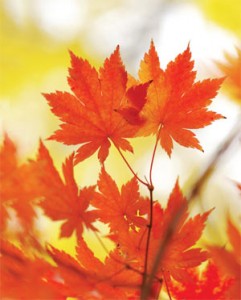 Q. I have a three year-old red Japanese Maple that looses it red leaf color. It leafs out with beautiful red leaves but by the end of summer they’re a dull green. What do I need to do to help this tree hold its color?
Q. I have a three year-old red Japanese Maple that looses it red leaf color. It leafs out with beautiful red leaves but by the end of summer they’re a dull green. What do I need to do to help this tree hold its color?
A. It is quite common for red leaf Japanese Maples to lose their red color by the end of summer. It is due to the day length, the level of stored sugar in the leaves, the sugar depletion rate and temperature. The sugars are produced by photosynthesis during daylight hours, as sunlight is absorbed and then stored in the leaves. The amount of sugar does vary by variety. The maple then uses for normal respiration and metabolic functions the sugars. The depletion rate, also called respiration, is a function the temperature. The red color is the strongest in the spring when the sunlight hours are increasing and the temperatures are still cool. This results in high sugar production and low consumption. The longest day of the year is June 21. As the days get shorter in mid to late summer the production of sugar decreases and with higher temperatures the consumption of sugar increases. This results in a net loss of sugar and as a result the red color fades to green as the sugar is depleted. Some cultivars produce more sugar or consume less and these varieties stay red longer. A tree planted in shade produces less sugar yet consumes the same as one planted in a sunny location; thus the loss of the red color is sooner in the summer. Here in the Bay Area, our summer fog or overcast has the same effect as shade. Generally, the red color of Japanese Maples lasts longer in the northern latitudes than in the southern areas because the hours of daylight are longer during the summer with usually cooler temperatures resulting in more sugars remaining in the leaves later in the year. So the frank answer as to what you can do to help keep the red color longer is nothing, so enjoy it while it last during the spring of the year.
Q. I’m landscaping my backyard but have three Netherland Dwarf Rabbits that live in the yard. They seem to eat everything but I don’t want to cage them up. Do you have any suggestions?
A. Unfortunately, I don’t have any solutions that are practical. Domestic or wild rabbits are a problem much like deer. They eat almost everything as you have found out. Rabbit repellents are available but they are water-soluble and the repeat applications do become tedious during the rainy season. You’ll have to make a choice between the rabbits and the plants. I think the best answer is segregated the rabbits from the rest of the landscape. If you do be sure to bury the containment wall about twelve to eighteen inches below the soil surface as the rabbits will escape by digging under the barrier. The other answer is a containment area that is off the ground. Caging the rabbits may be your best solution you have.
Buzz Bertolero is Executive Vice President of Navlet’s Garden Centers and a California Certified Nursery Professional. His web address is www.dirtgardener.com and you can send questions by email at dirtgarden@aol.com or to 360 Civic Drive Ste. ‘D’, Pleasant Hill, Calif. 94523 and on Facebook at Facebook.com/Buzz-Bertolero.
Leave a Reply